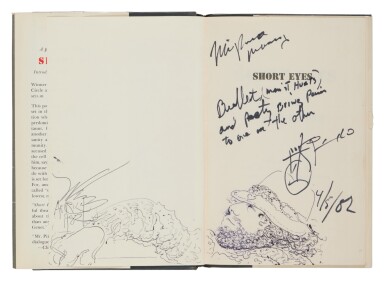Fine Books and Manuscripts
Fine Books and Manuscripts

Wong, Martin (Artist) — Miguel Piñero | An intimate portrait by Martin Wong
Lot Closed
December 16, 09:44 PM GMT
Estimate
6,000 - 8,000 USD
Lot Details
Description
Wong, Martin (Artist) — Miguel Piñero
Short Eyes. New York: Hill and Wang, 1975
8vo (206 x 137 mm). Original portrait by Martin Wong accomplished in ink (signed and dated April 1982) across the half-title and front free-endpaper, inscribed by the author on the half-title. Publisher's black cloth, spine lettered in silver, in the original dustjacket with photographic portrait of the author on the rear panel; lightly bumped and rubbed at head and tail of spine, unlabeled bookplates and "Cloud 9" ink stamp to front pastedown, dustjacket with tiny nicks at extremities, chip to the rear fold, sunning to spine panel.
An original Martin Wong drawing of his lover, Miguel Piñero.
Piñero, a poet, playwright, and one of the founders of the Nuyorican Poets Cafe, was a powerful influence on Wong's life and art. In 1978 Wong had moved from San Francisco to the Lower East Side of New York City in order to pursue his career as a painter. He met Piñero in 1982 on the opening night of the group exhibition Crime Show, at ABC No Rio, then at 156 Rivington Street. The gallery, run by the artist's collective known as Colab, had a "first come, first hung" submission policy, which gave Wong his first opportunity to exhibit his paintings in New York. Piñero gave a reading on the opening night, and very shortly after meeting the two moved in together.
The poet was essential to opening the neighborhood up to Wong—both in his social life and as a subject for his work. In an interview, Wong said, "Piñero pretty much introduced the neighborhood to me as subject matter. ... He used to show me around the neighborhood in the middle of the night and he'd read stories. ... He would just make up these stories. ... He'd make the neighborhood seem really dramatic and it was back then because everything was in ruins. He was a born entertainer, like one day I saw him reading a poem he'd just written to a wino who was passed out. He was just sitting on a garbage bag reading to this guy" (Ramirez).
In the first year and a half that they lived together, Wong produced a staggering number of significant works in collaboration with the poet—the paintings often featured Piñero's writing rendered in Wong's characteristic fingerspelling—which culminated in his 1984 solo exhibition Urban Landscapes at the Semaphore Gallery. The poet and the neighborhood maintained an influence Wong, who focused his attention on his "Loisaida" paintings ("Loisaida" being a nickname for the Lower East Side based on a Spanish phonetic spelling, coined by the poet, playwright, activist Bimbo Rivas—another leader of the Nuyorican movement). While Wong had experimented with including language in his paintings prior to meeting Piñero, he primarily extracted text from headlines in newspapers. After beginning their relationship, Wong not only utilized Piñero's own poetry, but employed language in the paintings in an increasingly Nuyorican mode—deploying the hybrid speech patterns overheard in the streets of the Lower East Side toward poetic ends.
Miguel Piñero's Short Eyes was written in 1972 while he was incarcerated at Sing Sing prison for armed robbery. The work, which portrays the murder of a pedophile in prison at the hands of fellow inmates, was first presented at the Riverside Church in Manhattan. It went on to become a Broadway production (the first by a Puerto Rican playwright), won an Obie Award and the New York Drama Critics Circle Award, and was nominated for six Tony Awards. Wong would later reconstruct a scene from Short Eyes in his painting The Annunciation According to Mickey Piñero.
The present copy is the first trade edition of the play and is affectionately inscribed by the author, "Mi primo Manny, | Bullet (man it hurts) and poetry brings pain to one or the other," signed, and dated 5 April 1982. The portrait is also signed by Wong and dated April 1982. This work of Wong's, then, dates just months after the two had met, when they were living together and at the height of their collaboration.
A truly rare and singular work by Martin Wong. Though Piñero (and his phantom-like doppelgängers) appears regularly in Wong's work—even in those accomplished after his death—the present portrait is a uniquely intimate gesture, composed not for public view, but hidden away in a book that Piñero presented to a friend. The portrait went on to be reproduced on the cover of an issue of a little-known contemporary zine, Conceptual Vandalism, which featured poetry and graffiti art—a medium which had always intersected with both Wong's work and the Nuyorican movement writ large. The issue features several works by Piñero, including his poem "King Heroin," the text of which Wong utilized in his 1984 painting of the same name.
Beyond just a portrait or a presentation copy, the totality of this volume itself is both a relic of, and embodies, a now-bygone era of downtown New York's artistic and literary worlds.
REFERENCE:
Yasmin Ramirez, "La Vida: The Life and Writings of Miguel Piñero in the Art of Martin Wong," Sweet Oblivion: The Urban Landscape of Martin Wong, 1998.
